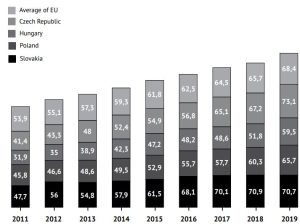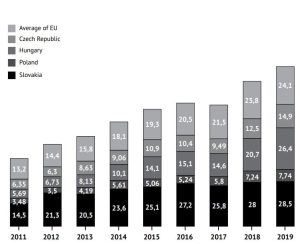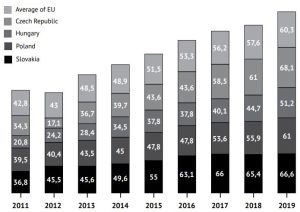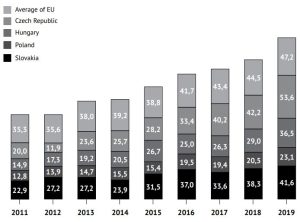Online shopping has become an increasingly common way of shopping in recent years. The main goal of the paper was to evaluate and compare the development of online shopping in the Visegrad Four countries (Slovakia, Czech Republic, Poland, Hungary). The paper outlines the theoretical basis of online shopping concept, describes the current situation of online shopping in the EU market and the main types of goods and services purchased through the Internet. Based on data from the Eurostat database, the paper outlines the development of online shopping in the years 2011 to 2019, the share of online purchases in the EU market and online purchases of goods and services within the V4 countries for the given years. We found that in all countries, an increasing trend of online shopping was recorded over the period under review, with the largest increase in the Czech Republic. There was also a growing share of online purchases from retailers in other EU countries, with the largest increase recorded in Hungary. With regard to online purchases of services, year-on-year decline over the period of two years has been recorded in Slovakia.
Introduction
The development of the Internet and the advancement of digital technologies have caused changes in consumer behavior. People are increasingly using online shopping instead of visiting a brick-and-mortar store (Menaka and Seethal 2018). Customers choose online shopping because they find it more convenient and faster than shopping in a brick-and-mortar store (Muthumani et al. 2017).
The world is currently facing a COVID-19 pandemic. It can be assumed that pandemic reasons are the cause behind the growing number of online shoppers. In 2020, more than 2 billion consumers worldwide bought goods or services online. Monthly visits to online stores in June 2020 reached a record 22 billion visits worldwide, with high demand especially for daily goods and services (Coppola 2021).
The aim of the paper is to evaluate the development of online shopping in the V4 countries in the years 2011 to 2019. The aim of the paper is to evaluate the share of online shopping in the EU market. Another goal is to compare online purchases of goods and services in the given years and point out the differences between the V4 countries.
Theoretical background of the issue
Online shopping is a form of e-commerce where consumers purchase products or services over the Internet directly from a retailer (Rahman et al. 2018). E-commerce involves the use of the Internet, web portals, mobile applications and browsers to make a purchase. These are therefore digitally enabled business transactions between sellers and customers. Online shopping is becoming a regular, everyday activity. Almost all Internet users are currently online shoppers (Laudon and Traver 2021). This type of shopping has gained popularity in recent years, especially because it is convenient and easy for people to shop from the comfort of their home (Prabha and Karunanidhi 2017). Jain (2016) outlines several advantages of online shopping over shopping in a brick-and-mortar store – saving time and energy, no time or geographical constraints, a wide selection of products, price comparison.
The most common type of e-commerce is B2C e-commerce, in which sellers try to gain individual customers. B2C e-commerce includes consumer online purchases of goods, online content, travel, finance, real estate and more (Laudon and Traver 2021). Over the next 5 years, B2C e-commerce is expected to grow by 20% annually (eMarketer 2020). Online retailing is currently the fastest growing retail channel, with the fastest growing customer base and ever-expanding product offer (Chaffey et al. 2019). An increasing number of people are choosing to shop online, even at foreign online merchants due to the geographically unrestricted shopping possibilities. Consumers living in EU Member States are increasingly using online shopping outside their home market. The share of online purchases from other EU countries is also rising due to the fact that EU consumer legislation in some cases provides them with greater benefits than online retailers in the domestic market (ECC Network 2021). In 2019, on average, 21% of consumers living in an EU Member State bought products from foreign markets in other EU Member States online. Compared to 2012, this is a 10% increase (Eurostat 2021).
The importance of online shopping in the context of B2C e-commerce is also growing in the Visegrad Four countries. With the growth of e-commerce, the Slovak Republic can compete with many large European countries. There are more than 12,600 e-shops registered in Slovakia (Heureka 2021). Out of 79% of Slovak internet users, 60% use online shopping. The best-selling category of online products in Slovakia is clothing and household goods (Eurostat 2020). The fastest growing e-commerce market in Europe is that of the Czech Republic (Morgan 2019). According to the Czech e-commerce portal (2021), there are currently more than 41,100 e-shops in the Czech Republic. 78.5% of Czechs over the age of 16 use the Internet, of which 64% make online purchases. The best-selling category of products purchased online in the Czech Republic is clothing, followed by trips, accommodation and household items (Eurostat 2020). In Poland, e-commerce is run by mainly of small and medium-sized enterprises. In 2020, 11,000 new e-shops were launched in Poland. Of the total population of 38 million, 77% are Internet users, with almost 80% shopping online in 2020 (Ecommerce News 2021). Poles most often buy clothes and household items (Eurostat 2020). In Hungary, online shopping is progressing at the slowest pace among the V4 countries. The most frequently purchased products in Hungary in 2019 were clothing and electronics (Eurostat 2020). In 2020, 65.7% of Hungarians shopped online, representing 4.86 million consumers (Statista 2021).
Methodology
The main goal of the paper is to evaluate and compare the development of online shopping in the Visegrad Four countries (Slovakia, Czech Republic, Poland, Hungary) in the years 2011 to 2019. The research sample consists of Internet users aged 16 to 74 who made at least one online purchase in 12 months. The unit of measurement is Percentage of internet users. In our research, we present three research questions: How has the share of online shoppers changed in the monitored years within the V4 countries? How has the proportion of online shoppers who shopped in e-shops of sellers in other EU countries changed? What differences can be observed in the online purchase of goods and services between the V4 countries in the monitored years? The identified research questions were answered using the analysis of secondary data. The data used in the analysis were obtained from the database of the Statistical Office of the European Communities (Eurostat). Specific data covered online purchases of goods or services, online purchases from retailers in other EU countries, online purchases of physical goods and online purchases of services. The obtained data were graphically processed in the RStudio program.
Results
The proportion of consumers shopping online varies from country to country. Based on the available data, it is possible to evaluate and compare the development of online shopping and point out changes or differences within the V4 countries.

Figure 1: Ordering goods or service online (% of internet users)
Source: author’s work based on Eurostat (2021)
Figure 1 shows the share of Internet users in the V4 countries who purchased goods or services over the Internet at least once every 12 months between 2011 and 2019, as well as the average share in EU countries. It can be stated from the figure that in all countries an increasing trend of the use of online shopping was recorded in the observed period. Among the V4 countries, in 2011 Slovakia had the largest share of online shoppers (47.70%) and Hungary the smallest (31.90%), while in 2019 the Czech Republic had the largest share of online shoppers (73.10%) and Hungary the smallest share (59.50%). In the monitored years, Slovakia reached a value comparable to the average of EU countries. Compared to other countries, the Czech Republic also recorded the highest increase in online shopping in 2019 compared to 2011, from 41.40% to 73.10%. The second highest increase was recorded in Hungary, where the share of online shoppers in 2019 increased by 27.60% compared to 2011. Slovakia achieved a share of 70.70% in 2019, which is 23% more than in 2011 (47.70%). The lowest increase was recorded in Poland, from 45.80% in 2011 to 65.70% in 2019.

Figure 2: Ordering goods or service online from sellers from other EU countries (% of internet users)
Source: author’s work based on Eurostat (2021)
In 2011, online purchases of goods or services from sellers from other EU countries did not even reach the level of 8% in any of the V4 countries, with the exception of Slovakia, which recorded a share of 14.50%, which is comparable to the EU average (Figure 2). In Poland, this trend lasted until 2019. All V4 countries and the EU average recorded an increasing trend in the monitored years. The largest growth was recorded in Hungary, from 5.69% in 2011 to 26.40% in 2019. In 2019, Slovakia recorded an increase in online purchases from other EU countries by 14% compared to 2011. In the Czech Republic, an increase of 8.55% was recorded in 2019 compared to 2011.

Figure 3: Buying physical goods online (% of internet users)
Source: author’s work based on Eurostat (2021)
Figure 3 shows the share of online purchases of physical goods, which includes the purchase of food or groceries, household items, medicines, clothing, sports equipment, hardware and electronics. Here, too, it is possible to observe an increasing trend in all V4 countries in the monitored years, including the average of EU countries. An exception is the Czech Republic, which recorded a sharp decline in 2012, from 34.30% to 17.10%, but in the following years the share of online purchases of physical goods grew in the Czech Republic. In the monitored years, Poland and Slovakia recorded values at a level comparable to the EU average. Slovakia, the Czech Republic and Hungary achieved an increase of approximately 30% in 2019 compared to 2011. In Poland, the growth in 2019 compared to 2011 was 21.50%.

Figure 4. Buying service online (% of internet users)
Source: author’s work based on Eurostat (2021)
Figure 4 shows the share of online service purchases, which includes telecommunications services, stock purchases, insurance purchases, financial services, travel, accommodation services and ticket purchases for various events. Within the average of the EU countries, in Hungary and Poland an increasing trend was recorded in the monitored years. Hungary recorded a value of 36.50% in 2019 compared to 14.90% in 2011. Poland recorded only 10.30% growth in 2019 compared to 2011. The largest increase compared to 2011 by 33.60% was recorded in the Czech Republic (from 20% to 53.60%) in 2019. However, the Czech Republic also recorded a more significant year-on-year decline, specifically in 2012 by almost 8%. Slovakia achieved in 2019 the share of online purchases of 41.60% compared to 22.90% in 2011. However, year-on-year declines were also recorded, notably in 2014 (by 3.30%) and in 2017 (about 3.40%).
Conclusion
The importance of e-commerce is currently growing. Online shopping is becoming an increasingly widespread way of shopping in the EU thanks to its undeniable benefits for customers as well as retailers. E-commerce is becoming more and more popular every day and is being used by more and more consumers (Sabou et al. 2017, Karthikeyan 2016, European Commission 2018).
Based on the above analyzes, it can be concluded that online shopping is growing every year. In all V4 countries and within the EU average, an increasing trend of this way of shopping was recorded in the years 2011 to 2019. The highest increase in online shopping compared to 2011 was achieved in 2019 by the Czech Republic, followed by Hungary, Slovakia and Poland. Analyzes also show that the share of online purchases made at sellers in other EU countries is also rising. The highest increase was recorded in Hungary, the lowest in Poland. Slovakia reached a value comparable to the EU average. The growing trend in the monitored years was also recorded for online shopping of physical goods and shopping of services. Regarding the online purchase of physical goods, Slovakia, the Czech Republic and Hungary achieved growth of approximately 30% between 2011 and 2019. With regard to purchasing services online, the Czech Republic recorded a decline in 2012 and Slovakia in 2014 and 2017.
The world is currently facing a COVID-19 pandemic. It is more than certain that the consequences of this pandemic will be felt in the sphere of online shopping. More and more consumers prefer online shopping to brick-and-mortar shopping because of pandemic reasons, such as restricted movement, lack of products in stores or health concerns (Reddy 2020, Sharma and Jhamb 2020, Shashidhar 2020). It is likely that the impact of the COVID-19 pandemic on online shopping in the future will vary from country to country, depending on the epidemiological as well as the socio-economic situation of the country.
Poznámky/Notes
This research is one of the partial outputs under the scientific research grants VEGA 1/0694/20 „Relational marketing research – perception of e-commerce aspects and its impact on purchasing behavior and consumer preferences” and VEGA 1/0609/19 „Research on the development of electronic and mobile commerce in the aspect of the impact of modern technologies and mobile communication platforms on consumer behavior and consumer preferences”.
Literatúra/List of References
- Chaffey, D., Hemphill, T. and Edmundson-Bird, D., 2019. Digital Business and E-commerce Management. UK: Pearson Education Limited, 2019. ISBN 978-1-292-19333-5.
- Coppola, D., 2021. E-commerce worldwide – Statistics & Facts. 2021. [online]. [cit. 2021-04-20]. Available at: <https://www.statista.com/topics/871/online-shopping/#dossierSummary__chapter4>
- Czech e-commerce, 2021. Size of e-commerce market. 2021. [online]. [cit. 2021-04-21]. Available at: <https://www.ceska-ecommerce.cz/>
- ECC Network, 2021. Your consumer rights when shopping online. 2021. [online]. [cit. 2021-04-21]. Available at: <https://www.eccireland.ie/shopping-online-consumer-rights/>
- E-commerce News, 2021. E-commerce in Poland. 2021. [online]. [cit. 2021-04-21]. Available at: <https://ecommercenews.eu/ecommerce-in-europe/ecommerce-poland/>
- eMarketer, 2020. Retail e-commerce sales, by country. 2020. [online]. [cit. 2021-04-20]. Available at: <https://www.emarketer.com/forecasts/5a53f4f2d8690c0d70ffaa06/5b2aab133808a50ff80464db>
- European Comission, 2018. Digital economy & society in the EU. 2018. [online]. [cit. 2021-04-24]. Available at: <https://ec.europa.eu/eurostat/cache/infographs/ict/>
- Eurostat, 2020. Internet purchases by individuals. 2020. [online]. [cit. 2021-04-21]. Available at: <https://ec.europa.eu/eurostat/databrowser/view/isoc_ec_ibuy/default/table?lang=en>
- Eurostat, 2021. Online purchases: from sellers from other EU countries. 2021. [online]. [cit. 2021-04-21]. Available at: <https://ec.europa.eu/eurostat/databrowser/view/ISOC_EC_IBUY__custom_850539/default/table?lang=en>
- Heureka, 2021. Slovaks reached a new record on e-shops in 2019. 2021. [online]. [cit. 2021-04-21]. Available at: <https://heureka.group/slovakia>
- Jain, A. S., 2016. Top 10 benefits of online shopping that make your life easy. 2016. [online]. [cit. 2021-04-20]. Available at: <https://toughnickel.com/frugal-living/Online-shopping-sites-benefits>
- Karthikeyan, G., 2016. Problems faced by online consumers. In: International Journal of Current Research and Modern Education. 2016, 1(1), 166-169. ISSN 2455-5428.
- Laudon, K. C. and Traver, C. G., 2021. E-commerce 2020-2021- business – technology – society. UK: Pearson Education Limited, 2021. ISBN 978-1-292-34316-7.
- Menaka, B. and Seethal, K., 2018. Recent trends in e-commerce. In: Shanlax International Journal of Commerce. 2018, 6(1), 40-44. ISSN 2320-4168.
- Morgan, J. P., 2019. E-commerce payments trends: European overview. 2019. [online]. [cit. 2021-04-21]. Available at: <https://www.jpmorgan.com/merchant-services/insights/reports/european-overview>
- Muthumani, A., Lavanya, V. and Mahalakshmi, R., 2017. Problems faced by customers on online shopping in Virudhunagar district. In: International Journal of Science Technology and Management. 2017, 6, 152-159. ISSN 2394-1537.
- Prabha, R. J. and Karunanidhi, M., 2017. A study on consumers problems towards online shopping. In: International Journal of Business and Management Invention. National conference on emerging trends and innovations in digital marketing. 2017. ISSN 2319-8028.
- Rahman, M. A., Islam, M. A., Esha, B. H., Sultana, N. and Chakravorty, S., 2018. Consumer buying behavior towards online shopping: An empirical study on Dhaka city, Bangladesh. In: Cogent & Business Management. 2018, 5(1), 1-22. ISSN 2331-1975.
- Reddy, A.,2020. Covid-19 impact: Consumers move more towards digital. 2020. [online]. [cit. 2021-04-24]. Available at: <https://www.thehindubusinessline.com/opinion/covid-19-impact-consumers-move-more-towards-digital/article31337127.ece>
- Sabou, S., Avram-Pop, B. and Zima, L. A., 2017. The impact of the problems faced by online customers on ecommerce. In: Studia Universitatis Babe-Bolyai Oeconomica. 2017, 62(2), 77-88. ISSN 1220-0506.
- Sharma, A. and Jhamb, D., 2020. Changing consumer behaviours towards online shopping – an impact of Covid 19. In: Academy of Marketing Studies Journal. 2020, 24(3). ISSN 1095-6298.
- Shashidar, A., 2020. Coronavirus crisis: Snapdeal goes ‘local’ to ensure faster deliveries amid lockdown. In: Business Today. 2020, 2020(4). ISSN 1810-9306.
- Statista, 2021. E-commerce Hungary. [online]. [cit. 2021-04-21]. Available at: <https://www.statista.com/outlook/dmo/ecommerce/hungary>
Kľúčové slová/Key words
online shopping, internet, Visegrad Four, B2C, e-commerce, customers
online nakupovanie, internet, Vyšehradská štvorka, B2C, e-commerce, zákazníciJEL klasifikácia/JEL Classification
M30, M31
Résumé
Rozvoj online nakupovania v rámci B2C e-commerce v krajinách Vyšehradskej štvorky
Online nakupovanie je v posledných rokoch čoraz bežnejším spôsobom nakupovania. Hlavným cieľom príspevku bolo zhodnotiť a porovnať vývoj online nakupovania v krajinách Vyšehradskej štvorky (Slovensko, Česká republika, Poľsko, Maďarsko). Príspevok načrtáva teoretické východiská konceptu online nakupovania, popisuje súčasnú situáciu online nakupovania na trhu EÚ a hlavné druhy tovarov a služieb nakupovaných cez internet. Na základe údajov z databázy Eurostatu práca načrtáva vývoj online nakupovania v rokoch 2011 až 2019, podiel online nákupov na trhu EÚ a online nákupov tovarov a služieb v rámci krajín V4 za dané roky. Zistili sme, že vo všetkých krajinách bol za sledované obdobie zaznamenaný stúpajúci trend online nakupovania, pričom najväčší nárast bol zaznamenaný v Českej republike. Rastie aj podiel online nákupov u predajcov v iných krajinách EÚ, pričom najväčší nárast zaznamenalo Maďarsko. V oblasti online nákupov služieb je na Slovensku zaznamenaný medziročný pokles za obdobie dvoch rokov.
Recenzované/Reviewed
16. August 2021 / 20. August 2021












